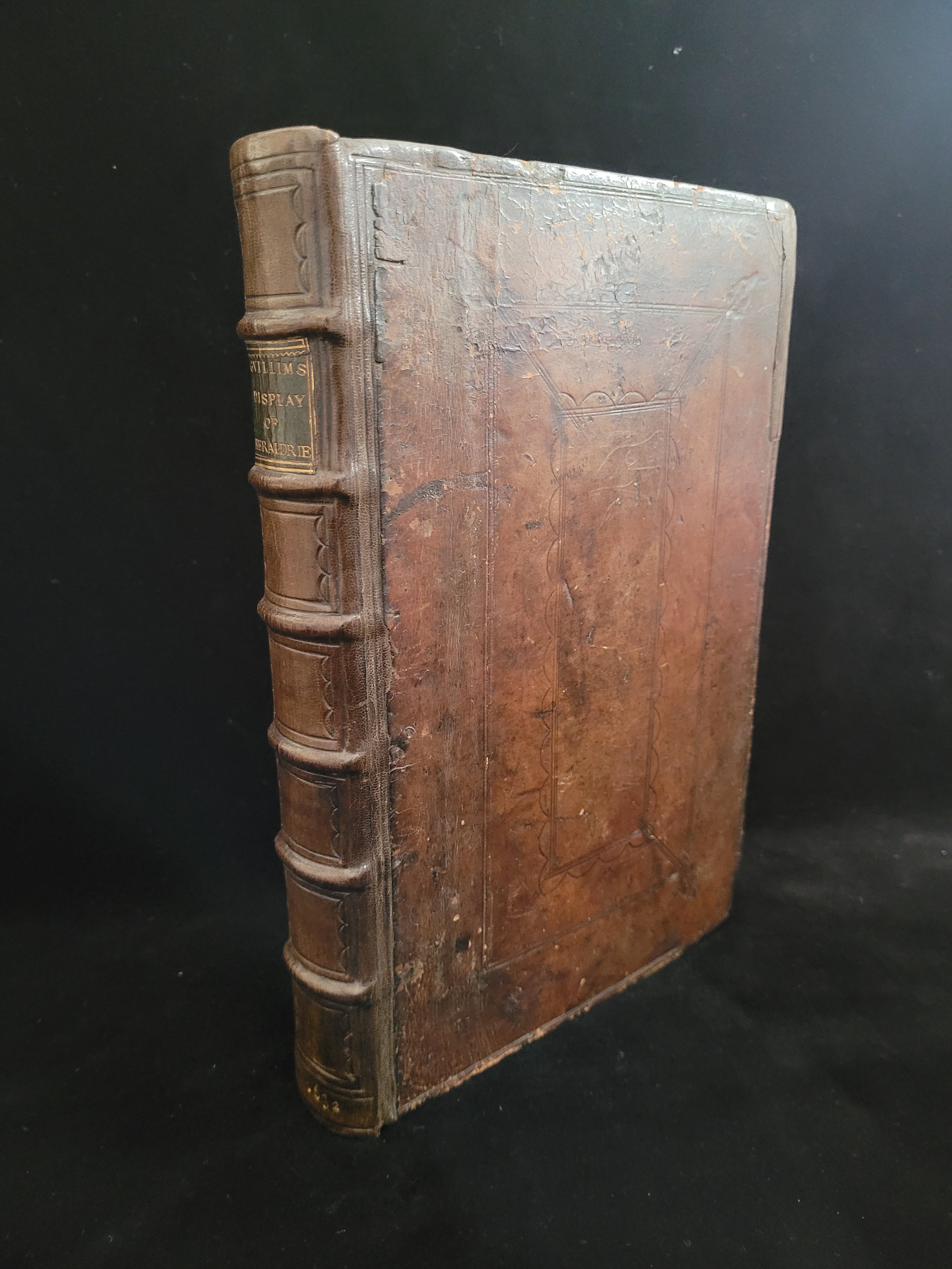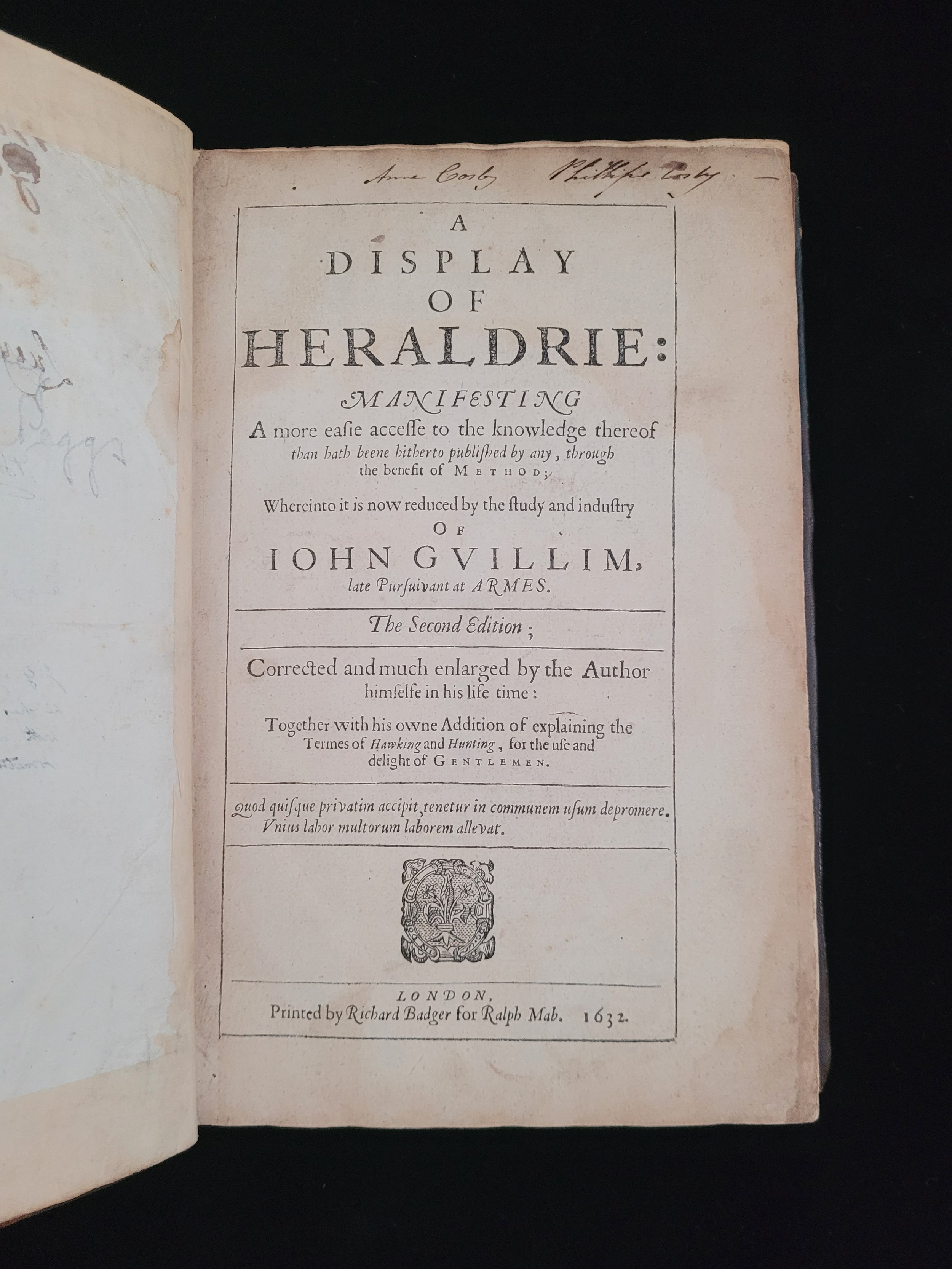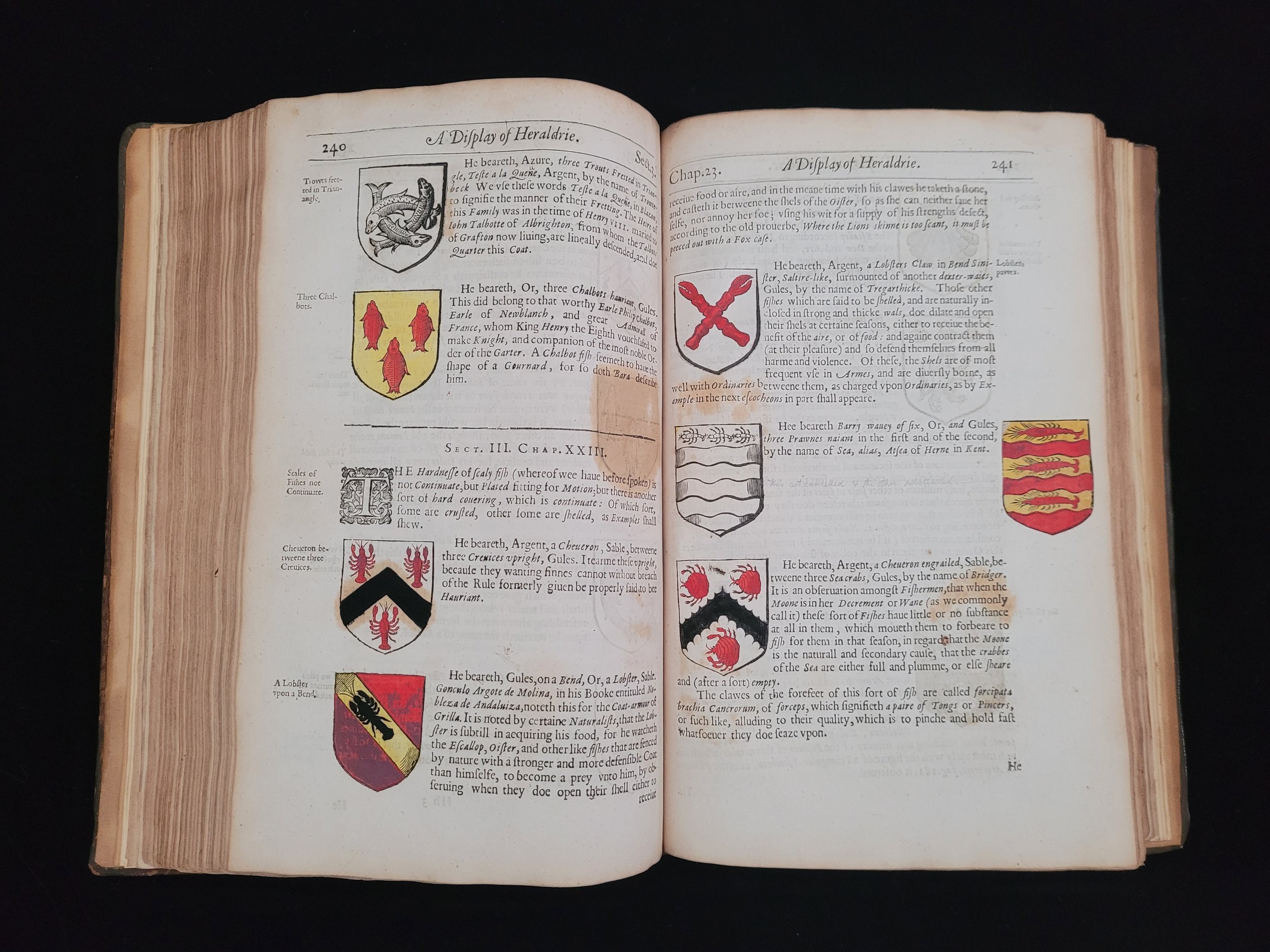 Image 1 of 5
Image 1 of 5

 Image 2 of 5
Image 2 of 5

 Image 3 of 5
Image 3 of 5

 Image 4 of 5
Image 4 of 5

 Image 5 of 5
Image 5 of 5






A Display of Heraldrie: Manifesting A more easie accesse to the knowledge thereof than hath beene hitherto published by any, through the benefit of method; Whereinto it is now reduced by the study...
GUILLIM, John. A Display of Heraldrie: Manifesting A more easie accesse to the knowledge thereof than hath beene hitherto published by any, through the benefit of method; Whereinto it is now reduced by the study and industry of…
London: Printed by Richard Badger for Ralph Mab, 1632
Small folio, full contemporary panelled calf, skilfully rebacked, contrasting leather label gilt to spine; ruled in blind with five raised bands and gilt date to foot; endpapers renewed; pp. [xxvi], 431, [ix]; the final three pages with the numbers provided in manuscript; together with 20th century pages of index notes in a previous owner’s hand, listing the names of the various houses; containing over 1000 woodcut coats of arms, many hand coloured; along with 9 full-page to the rear of the text; woodcut head/tailpieces, borders and initials throughout; with numerous contemporary or near-contemporary manuscript notes to margins; containing leaves 193-4, frequently wanting; pp. 411-12 misnumbered but present, with correct page numbers added in pencil; and the Howard achievement award between p. 420 and 421; boardsa little rubbed and scratched, with repair to the outer edge; some pages mounted on guards, paper repairs throughout, most extensively to the original front endpaper and p. [411], with some marginal dampstaining; the odd ink splash to text affecting one or two letters; bleeding and offsetting from many of the coats of arms, affecting versos; outer margin of p. 423 closely cropped at edge; Provenance: Ex Libris of Walter Sidney Scott to ffep, along with bookplate of Henry Gough, and manuscript notes of Lady Cosby, wife of Sir Henry Augustus Montagu, dated 1828, to front paste-down; numerous manuscript notes in various hands to original ffep, including Lucy Fuller (mostly 19th century); pencil markings outlining the watermark opposite title; two Cosby names in ink to title.
Second edition, corrected and enlarged by the author. The work also contains an explanation of the ‘Termes of Hawking and Hunting, for the use and delight of Gentlemen’. An interesting copy, bibliographically, containing much marginalia.
Divided into six sections, this extensive work on Heraldry "was to remain the standard textbook on English heraldry until the second half of the eighteenth century, and it is still regularly used by working heralds in the twenty-first century". Originally published in 1610, the book was reprinted as early as 1611, and following the author’s death seven further editions appeared, the last in 1724.
John Guillim (c. 1565 – 1621) was an antiquarian and officer of arms at the College of Arms in London. Guillim’s first involvement with Heraldry was the Earl Marshal's warrant, which permitted him to wear the tabard of the Portsmouth Pursuivant Extraordinary, and in 1618 he was appointed Rouge Croix Pursuivant of Arms in Ordinary. Guillim devoted most of his life to heraldic studies and to writing the Displae which proved to be the most well-organised and encyclopaedic work of English heraldry in its time. Covering the social history and origins of heraldry, the author expounds upon the various images and emblems appearing on coats of arms, as well as the various kinds of escutcheons and the families to whom they belong.
An attractive copy of a scarce work.
GUILLIM, John. A Display of Heraldrie: Manifesting A more easie accesse to the knowledge thereof than hath beene hitherto published by any, through the benefit of method; Whereinto it is now reduced by the study and industry of…
London: Printed by Richard Badger for Ralph Mab, 1632
Small folio, full contemporary panelled calf, skilfully rebacked, contrasting leather label gilt to spine; ruled in blind with five raised bands and gilt date to foot; endpapers renewed; pp. [xxvi], 431, [ix]; the final three pages with the numbers provided in manuscript; together with 20th century pages of index notes in a previous owner’s hand, listing the names of the various houses; containing over 1000 woodcut coats of arms, many hand coloured; along with 9 full-page to the rear of the text; woodcut head/tailpieces, borders and initials throughout; with numerous contemporary or near-contemporary manuscript notes to margins; containing leaves 193-4, frequently wanting; pp. 411-12 misnumbered but present, with correct page numbers added in pencil; and the Howard achievement award between p. 420 and 421; boardsa little rubbed and scratched, with repair to the outer edge; some pages mounted on guards, paper repairs throughout, most extensively to the original front endpaper and p. [411], with some marginal dampstaining; the odd ink splash to text affecting one or two letters; bleeding and offsetting from many of the coats of arms, affecting versos; outer margin of p. 423 closely cropped at edge; Provenance: Ex Libris of Walter Sidney Scott to ffep, along with bookplate of Henry Gough, and manuscript notes of Lady Cosby, wife of Sir Henry Augustus Montagu, dated 1828, to front paste-down; numerous manuscript notes in various hands to original ffep, including Lucy Fuller (mostly 19th century); pencil markings outlining the watermark opposite title; two Cosby names in ink to title.
Second edition, corrected and enlarged by the author. The work also contains an explanation of the ‘Termes of Hawking and Hunting, for the use and delight of Gentlemen’. An interesting copy, bibliographically, containing much marginalia.
Divided into six sections, this extensive work on Heraldry "was to remain the standard textbook on English heraldry until the second half of the eighteenth century, and it is still regularly used by working heralds in the twenty-first century". Originally published in 1610, the book was reprinted as early as 1611, and following the author’s death seven further editions appeared, the last in 1724.
John Guillim (c. 1565 – 1621) was an antiquarian and officer of arms at the College of Arms in London. Guillim’s first involvement with Heraldry was the Earl Marshal's warrant, which permitted him to wear the tabard of the Portsmouth Pursuivant Extraordinary, and in 1618 he was appointed Rouge Croix Pursuivant of Arms in Ordinary. Guillim devoted most of his life to heraldic studies and to writing the Displae which proved to be the most well-organised and encyclopaedic work of English heraldry in its time. Covering the social history and origins of heraldry, the author expounds upon the various images and emblems appearing on coats of arms, as well as the various kinds of escutcheons and the families to whom they belong.
An attractive copy of a scarce work.
GUILLIM, John. A Display of Heraldrie: Manifesting A more easie accesse to the knowledge thereof than hath beene hitherto published by any, through the benefit of method; Whereinto it is now reduced by the study and industry of…
London: Printed by Richard Badger for Ralph Mab, 1632
Small folio, full contemporary panelled calf, skilfully rebacked, contrasting leather label gilt to spine; ruled in blind with five raised bands and gilt date to foot; endpapers renewed; pp. [xxvi], 431, [ix]; the final three pages with the numbers provided in manuscript; together with 20th century pages of index notes in a previous owner’s hand, listing the names of the various houses; containing over 1000 woodcut coats of arms, many hand coloured; along with 9 full-page to the rear of the text; woodcut head/tailpieces, borders and initials throughout; with numerous contemporary or near-contemporary manuscript notes to margins; containing leaves 193-4, frequently wanting; pp. 411-12 misnumbered but present, with correct page numbers added in pencil; and the Howard achievement award between p. 420 and 421; boardsa little rubbed and scratched, with repair to the outer edge; some pages mounted on guards, paper repairs throughout, most extensively to the original front endpaper and p. [411], with some marginal dampstaining; the odd ink splash to text affecting one or two letters; bleeding and offsetting from many of the coats of arms, affecting versos; outer margin of p. 423 closely cropped at edge; Provenance: Ex Libris of Walter Sidney Scott to ffep, along with bookplate of Henry Gough, and manuscript notes of Lady Cosby, wife of Sir Henry Augustus Montagu, dated 1828, to front paste-down; numerous manuscript notes in various hands to original ffep, including Lucy Fuller (mostly 19th century); pencil markings outlining the watermark opposite title; two Cosby names in ink to title.
Second edition, corrected and enlarged by the author. The work also contains an explanation of the ‘Termes of Hawking and Hunting, for the use and delight of Gentlemen’. An interesting copy, bibliographically, containing much marginalia.
Divided into six sections, this extensive work on Heraldry "was to remain the standard textbook on English heraldry until the second half of the eighteenth century, and it is still regularly used by working heralds in the twenty-first century". Originally published in 1610, the book was reprinted as early as 1611, and following the author’s death seven further editions appeared, the last in 1724.
John Guillim (c. 1565 – 1621) was an antiquarian and officer of arms at the College of Arms in London. Guillim’s first involvement with Heraldry was the Earl Marshal's warrant, which permitted him to wear the tabard of the Portsmouth Pursuivant Extraordinary, and in 1618 he was appointed Rouge Croix Pursuivant of Arms in Ordinary. Guillim devoted most of his life to heraldic studies and to writing the Displae which proved to be the most well-organised and encyclopaedic work of English heraldry in its time. Covering the social history and origins of heraldry, the author expounds upon the various images and emblems appearing on coats of arms, as well as the various kinds of escutcheons and the families to whom they belong.
An attractive copy of a scarce work.

